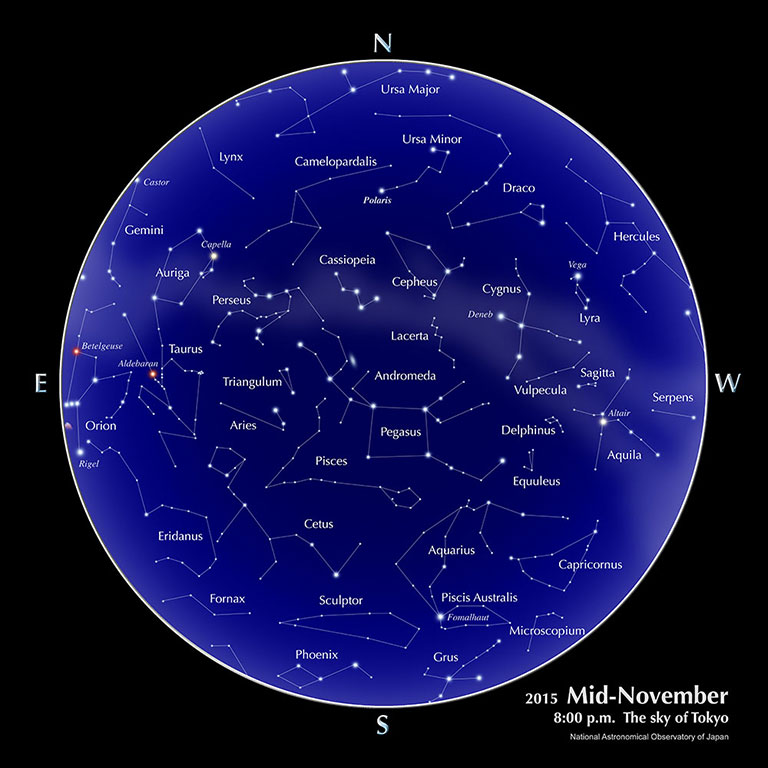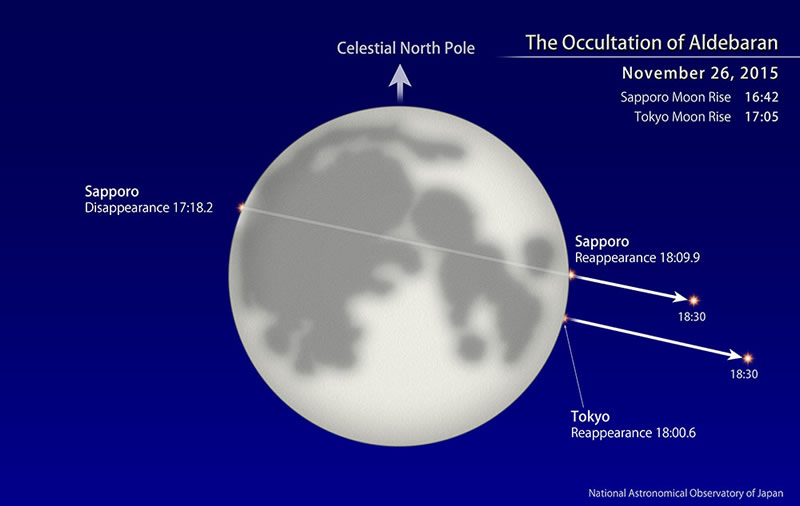November, 2015
Index
The sky of Tokyo

Calendar (November)
| 3 | Last Quarter / Culture Day (National holiday) |
| 12 | New Moon / Peak of Northern Taurids Meteor Shower (There is no effect of moonlight) |
| 17 | Mercury at superior conjunction |
| 18 | Peak of Leonids around 1 p.m. (The moon sets before mid of night) |
| 19 | First Quarter / Neptune at stationary point |
| 23 | Labor Thanksgiving Day [Kinro-kansha no hi] (National holiday) |
| 26 | Full Moon |
| 30 | Saturn at conjunction |
The posted peak day and time of meteor showers is based on the prediction of IMO(International Meteor Organization).
Planets
- Mercury
- Mercury appears close to the Sun, making observations difficult. It reaches superior conjunction on the 17th.
- Venus
- Venus shines particularly brightly in the eastern sky before sunrise. Its brightness is -4.3 magnitude to -4.2 magnitude.
- Mars
- Mars moves from the constellation Leo to the constellation Virgo. Look in the eastern sky before sunrise. The brightness is 1.7 magnitude to 1.5 magnitude.
- Jupiter
- Jupiter, located in the constellation Leo, shines brightly in the eastern sky before sunrise. The brightness is -1.8 magnitude to -2.0 magnitude.
- Suturn
- Saturn appears close to the Sun, making observations difficult. It reaches conjunction on the 30th.
Source: Ephemeris Computation Office, NAOJ
With the “Sky Viewer” you can easily explore the appearance of a typical urban night sky (planets and constellations are visible).The Celestial Phenomenasection of the glossary explains the planetary phenomena terms: greatest elongation, opposition, conjunction, stationary, etc.
Topics
The Moon Passing Close to Venus, Mars, and Jupiter

In the eastern sky before sunrise, -4th magnitude Venus and -2 magnitude Jupiter stand out very well. Mars can also be seen close to Venus and Jupiter, but compared to the negative magnitudes of Venus and Jupiter, it is a relatively modest brightness.
In the beginning of November, Venus and Jupiter appear close together; the closest is on the 4th. Also, from November 6 to 8, the thin Moon can be seen close to these 3 planets making a beautiful sight.
Aldebaran and the Moon Close Together, the Occultation of Aldebaran

On November 26, the Moon passes in front of Aldebaran, a 1st magnitude star in the constellation Taurus causing an “Occultation of Aldebaran.”
The reappearance can be seen throughout almost all of Japan, excluding parts of Kyushu, but the disappearance can only be seen from areas north of the Kanto (Tokyo) region. However, even in areas which can see the disappearance or reappearance, these phenomena occur while the Moon and Aldebaran are located low in the sky, making it difficult to observe them with the naked eye. It would be best to use binoculars or a telescope to observe.
For a while after the Occultation of Alderbaran has finished, you can see Aldebaran glowing bright orange right next to the full moon as it rises high in the sky.
| Time of Moon Rise | Time of Disappearance (Alderbaran’s Elevation) | Time of Reappearance (Alderbaran’s Elevation) | |
|---|---|---|---|
| Sapporo | 16:42 | 17:18.2 (5.3deg) | 18:09.9 (14.5deg) |
| Sendai | 16:55 | 17:11.8 (2.3deg) | 18:03.9 (12.1deg) |
| Tokyo | 17:05 | 17:09.2 (0.1) | 18:00.6 (10.1deg) |
| Kyoto | 17:22 | Not Visible | 18:00.3 (6.7deg) |
| Fukuoka | 17:47 | Not Visible | 17:59.8 (2.0deg) |
| Naha | 18:11 | Not Visible | Not Visible |